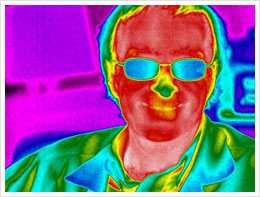September 30, 2008
Infrared Camera Provides Internship Opportunities
$16,000 technology will be used for tumor research.
Icess Fernandez
email
courtesy of The Shreveport Times

Juan Rodriguez of Centenary College poses with an infrared camera he was able to purchase with grant funds. Among other projects the $16,000.00 camera will be used to conduct tumor research.
(Douglas Collier/The Times)
Centenary College junior Clayton Newell will soon be able to see the color of tumors.
As part of an upcoming internship at LSU Health Sciences Center in Shreveport, Newell will use a credit card-sized camera with the capacity to detect the slightest differences in temperature.
"(The camera) is going to be used to view tumors in a different aspect than before," he said.
Newell will be the first designated student from the private college to use a new infrared camera recently purchased by the college. The camera will provide a chance to develop internship opportunities for students in several fields, said Keen Chair of Engineering Juan Rodriguez, physics department chairman.
"It's designed to provide internship opportunities for students for things like research, projects or internships with engineering firms," he said. "We provide the equipment and students. They provide the opportunity."
The camera, bought with money from a grant from the Louisiana Board of Regents, costs about $16,000 and is able to detect variations in temperature on any given surface up to a 20th of a degree.
For example, the camera could detect where someone places his or her hand on a desk and the area's temperature. The same technology is used by the military to find where someone could behiding by using body temperature, he said.

Juan Rodriguez
Rodriguez applied for the grant last year after spending a summer on a research project using a similar camera. The project studied the body's reaction to blood loss.
As Rodriguez helped with the research, he thought about how the camera could be used for other applications. Looking at the amount of heat a tumor emanates compared to how much it does once it's treated "allows us to assess how well treatments work," he said.
As soon as he received the camera, Rodriguez e-mailed the campus for ideas for its use. "Several faculty members said they would think about it," he said. Rodriguez also said he was open to projects from the private sector as long as they provide internships for students.
Newell, a biochemistry major, is currently learning how to work the camera and to read the information it gives. He's also preparing by watching surgeries at LSUHSC to determine the best position for the camera.
"I'm kinda excited but nervous at the same time," he said. "I've never done anything like this before."
